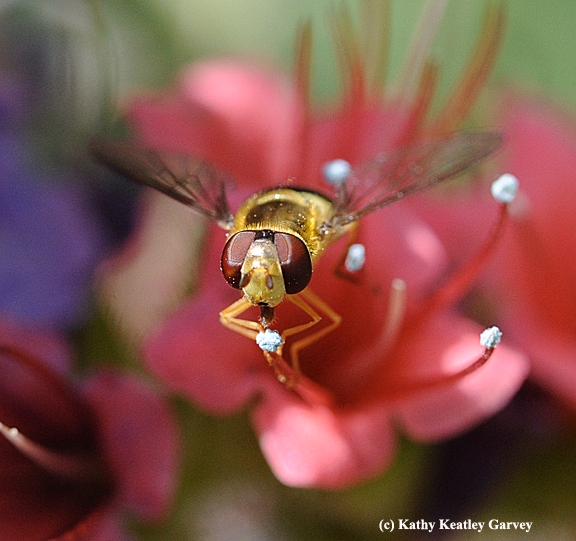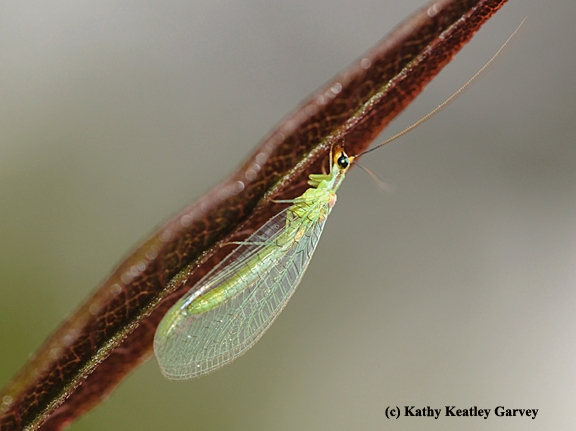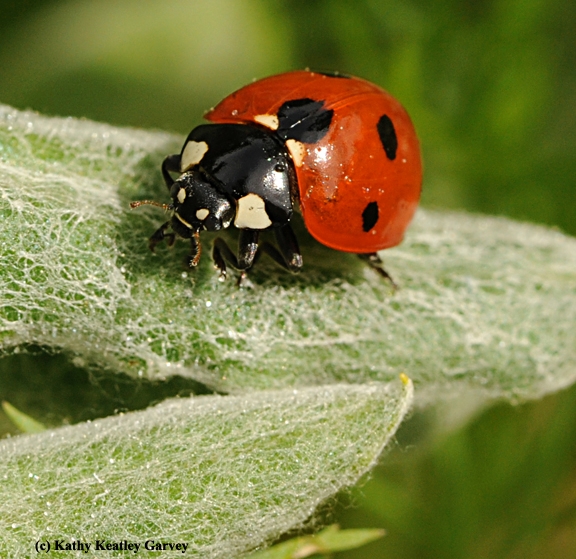Think of them as "the good guys" and "the good girls."
Insects such as lacewings, lady beetles and flower flies.
We're delighted to see that the Xerces Society for Invertebrate Conservation has just published a 250-page book on "Farming with Native Beneficial Insects."
The book advocates the use of beneficial insects to prey upon crop pests, thus "reducing or eliminating the use of pesticides," say co-authors Eric Lee-Mäder, Jennifer Hopwood, Mace Vaughan, Scott Hoffman Black, and Lora Morandin.
"This comprehensive guide describes how to recognize these insects and their habitat, and how to evaluate, design, and improve habitat for them," they write. They offer specific solutions, including native plant field borders, mass insectary plantings, hedgerows, cover crops, buffer strips, beetle banks, and brush piles.
The much-acclaimed book, available for purchase on the Xerces website, is drawing well deserved accolades, including this one from Claire Kremen, professor and co-director of the Berkeley Food Institute, University of California, Berkeley:
“If you are a grower or a backyard gardener, this is a ‘must have.' Readable and filled with gorgeous photos and handy charts, this book provides reams of information about how to get the upper hand on your pest issues with reduced or no pesticide use.”
Xerces officials say the release of Farming with Native Beneficial Insects coincides with its launch of a new nationwide workshop series on natural pest control: the Conservation Biological Control Short Course. The course, to begin in the West and Midwest, "provides farmers, crop consultants, and government farm agency staff with a comprehensive, hands-on training in the natural pest management strategies described in the book. A similar workshop model previously offered by Xerces trained tens of thousands of people in farm communities across the U.S. to conserve bees and restore pollinator habitat, and helped facilitate the restoration of more than 100,000 acres of wildflower habitat for bees."
Speaking of "the good guys" and "the good girls," be sure to read the UC Statewide Integrated Pest Management Project's website on beneficial insects and natural enemies. The natural enemies include assassin bugs, bigeyed bugs, brown lacewings, convergent lady beetles, damsel bugs, dustywings, syrphid flies and twicestabbed lady beetles.
What is Integrated Pest Management (IPM)? "Integrated pest management uses environmentally sound, yet effective, ways to keep pests from annoying you or damaging plants. IPM programs usually combine several pest control methods for long-term prevention and management of pest problems without harming you, your family, or the environment. Successful IPM begins with correct identification of the pest. Only then can you select the appropriate IPM methods and materials."
UC IPM points out:
- Many pests can be managed without the use of pesticides.
- Use pesticides only if nonchemical controls are ineffective and pests are reaching intolerable levels.
- Use pesticides in combination with the methods described above.
- Choose pesticides carefully. Use the least toxic, most effective material to protect human health and the environment.
- Examples of least toxic insecticides include:
- Soaps;
- Oils; and
- Microbials such as Bacillus thuringiensis (Bt) and spinosad.
The more we learn about pests and the natural enemies of pests, the oft-heard quote, "Keep your friends close and your enemies closer" rings quite true. The more we learn about our enemies, the less likely they will be able to harm us.
Attached Images:

A syrphid fly, aka flower fly or hover fly, nectaring on a tower of jewels. (Photo by Kathy Keatley Garvey)

A lacewing glows in the afternoon sun. Larvae eat such soft-bodied insects as mealybugs, psyllids, thrips, mites, whiteflies, aphids, small caterpillars, leafhoppers, and insect eggs, according to the UC IPM website. (Photo by Kathy Keatley Garvey)

The lady beetle, aka ladybug, is well known for its voracious appetite of aphids. (Photo by Kathy Keatley Garvey)